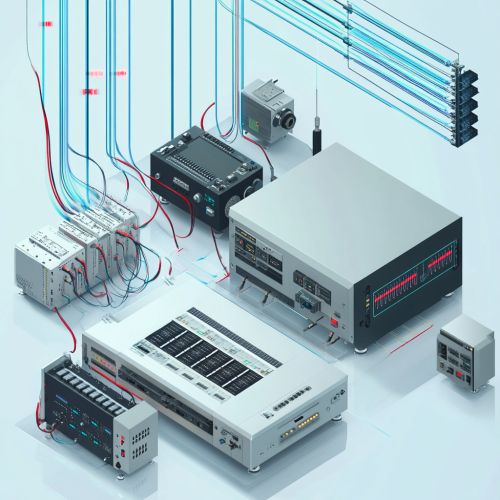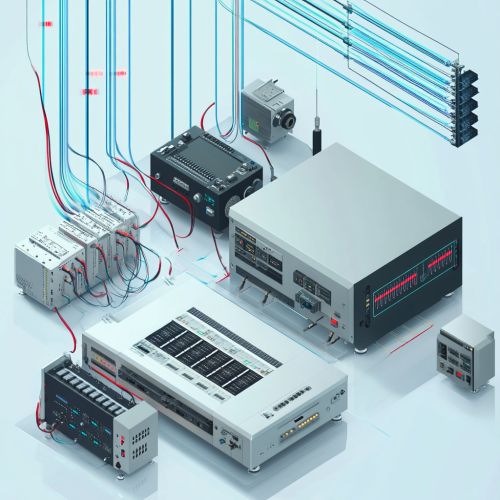Cross-Correlation: Difference between revisions
(Created page with "== Introduction == Cross-correlation is a statistical measure that quantifies the similarity between two signals as a function of the time-lag applied to one of them. It is widely used in various fields such as signal processing, time series analysis, and pattern recognition. Cross-correlation is a fundamental tool in the analysis of time-dependent phenomena and is closely related to the concept of autocorrelation. == Mathematical Definition == Cross-correlation bet...") |
No edit summary |
||
| Line 31: | Line 31: | ||
In communications, cross-correlation is used to synchronize signals and to detect the timing offset between transmitted and received signals. This is crucial in systems such as GPS and digital communications. | In communications, cross-correlation is used to synchronize signals and to detect the timing offset between transmitted and received signals. This is crucial in systems such as GPS and digital communications. | ||
[[Image:Detail-97741.jpg|thumb|center|An illustration of signal processing equipment in use.|class=only_on_mobile]] | |||
[[Image:Detail-97742.jpg|thumb|center|An illustration of signal processing equipment in use.|class=only_on_desktop]] | |||
== Computational Methods == | == Computational Methods == | ||
Latest revision as of 12:34, 30 August 2024
Introduction
Cross-correlation is a statistical measure that quantifies the similarity between two signals as a function of the time-lag applied to one of them. It is widely used in various fields such as signal processing, time series analysis, and pattern recognition. Cross-correlation is a fundamental tool in the analysis of time-dependent phenomena and is closely related to the concept of autocorrelation.
Mathematical Definition
Cross-correlation between two continuous functions \( f(t) \) and \( g(t) \) is defined as: \[ (f \star g)(\tau) = \int_{-\infty}^{\infty} f(t) \overline{g(t + \tau)} \, dt \] where \( \overline{g(t + \tau)} \) denotes the complex conjugate of \( g(t + \tau) \) and \( \tau \) is the time-lag.
For discrete functions \( f[n] \) and \( g[n] \), the cross-correlation is given by: \[ (f \star g)[k] = \sum_{n=-\infty}^{\infty} f[n] \overline{g[n + k]} \]
Properties
Cross-correlation has several important properties:
- **Linearity**: Cross-correlation is a linear operation.
- **Symmetry**: For real-valued functions, \( (f \star g)(\tau) = (g \star f)(-\tau) \).
- **Shift Invariance**: Shifting one of the functions results in a corresponding shift in the cross-correlation function.
Applications
Cross-correlation is utilized in numerous applications, including but not limited to:
Signal Processing
In signal processing, cross-correlation is used to detect the presence of a known signal within a noisy environment. This technique is essential in radar and sonar systems, where the goal is to identify the time delay between transmitted and received signals.
Time Series Analysis
In time series analysis, cross-correlation helps in identifying the relationship between two time series. It is particularly useful in econometrics and climatology for analyzing the lagged effects between different variables.
Pattern Recognition
Cross-correlation is employed in pattern recognition to match templates within images. This method is widely used in computer vision for object detection and image registration.
Communications
In communications, cross-correlation is used to synchronize signals and to detect the timing offset between transmitted and received signals. This is crucial in systems such as GPS and digital communications.


Computational Methods
There are various methods to compute cross-correlation efficiently:
Direct Computation
The direct computation involves evaluating the cross-correlation formula directly. This method is straightforward but computationally expensive for large datasets.
Fast Fourier Transform (FFT)
The Fast Fourier Transform (FFT) is an efficient algorithm to compute the cross-correlation. By transforming the signals into the frequency domain, the convolution theorem allows the cross-correlation to be computed as the inverse FFT of the product of the FFTs of the two signals.
Normalized Cross-Correlation
Normalized cross-correlation is used to compare signals of different amplitudes. It is defined as: \[ \text{NCC}(\tau) = \frac{(f \star g)(\tau)}{\sqrt{(f \star f)(0) \cdot (g \star g)(0)}} \] This normalization ensures that the cross-correlation values range between -1 and 1.
Theoretical Considerations
Cross-correlation is closely related to several other mathematical concepts:
Convolution
While cross-correlation measures similarity, convolution combines two functions to produce a third function. The convolution of \( f \) and \( g \) is defined as: \[ (f * g)(\tau) = \int_{-\infty}^{\infty} f(t) g(\tau - t) \, dt \]
Autocorrelation
Autocorrelation is a special case of cross-correlation where the function is correlated with itself. It is defined as: \[ (f \star f)(\tau) = \int_{-\infty}^{\infty} f(t) \overline{f(t + \tau)} \, dt \]
Correlation Coefficient
The correlation coefficient is a normalized measure of the strength and direction of the linear relationship between two variables. It is related to the normalized cross-correlation at zero lag.
Practical Considerations
When applying cross-correlation in practice, several factors must be considered:
Noise
Noise can significantly affect the cross-correlation results. Techniques such as filtering and windowing are often used to mitigate the impact of noise.
Edge Effects
Edge effects occur when the signals are finite in length. Padding the signals with zeros or using window functions can help reduce these effects.
Computational Complexity
For large datasets, the computational complexity of cross-correlation can be a limiting factor. Efficient algorithms and parallel processing techniques are often employed to address this issue.
